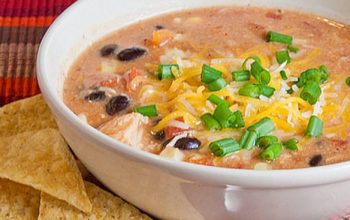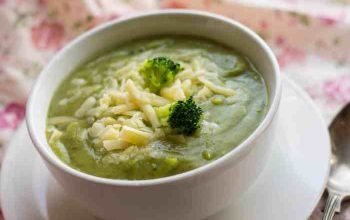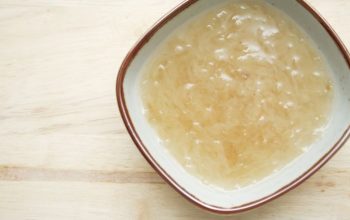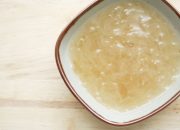Pinto Bean Soup: A Culinary Exploration
Recipes pinto bean soup – Pinto bean soup, a hearty and versatile dish, holds a prominent place in culinary traditions across the Americas. Its adaptability allows for countless variations, each showcasing unique flavor profiles and cultural influences. This exploration delves into the diverse world of pinto bean soup, examining its variations, cooking techniques, key ingredients, and serving suggestions.
Pinto Bean Soup Variations

Source: healthiersteps.com
The simplicity of pinto bean soup allows for extensive creativity. Below are three distinct recipes, each offering a different flavor profile, followed by variations focusing on ingredient substitutions and a look at the cultural origins of several variations.
| Ingredient | Quantity | Preparation | Notes |
|---|---|---|---|
| Dried Pinto Beans | 1 cup | Soaked overnight, then rinsed | Use high-quality beans for best results. |
| Onion | 1 medium | Chopped | Yellow or white onion works well. |
| Garlic | 2 cloves | Minced | Fresh garlic adds a vibrant flavor. |
| Vegetable Broth | 6 cups | Use low-sodium broth for better flavor control. | |
| Cumin | 1 tsp | Added with the onion and garlic | Ground cumin is preferred. |
| Chili Powder | 1 tbsp | Added with the onion and garlic | Adjust to your preferred spice level. |
| Bay Leaf | 1 | Removed before serving | Adds depth of flavor. |
| Salt and Pepper | To taste | Season at the end of cooking. |
Five unique variations on a classic pinto bean soup recipe, focusing on substitutions for common ingredients:
- Spicy Variation: Add a diced jalapeño pepper, a pinch of cayenne pepper, and a splash of your favorite hot sauce.
- Creamy Variation: Stir in a dollop of sour cream or crème fraîche before serving.
- Smoky Variation: Add a smoked paprika and a tablespoon of liquid smoke.
- Vegetarian Variation: Substitute vegetable broth for chicken broth and add extra vegetables such as carrots, celery, and bell peppers.
- Black Bean Variation: Substitute half of the pinto beans with black beans for a different flavor and texture.
Cultural origins of three different pinto bean soup recipes:
- Mexican Pinto Bean Soup: Often features a blend of chiles, onions, garlic, and cumin, reflecting the rich culinary heritage of Mexico.
- Tex-Mex Pinto Bean Soup: This variation frequently incorporates ingredients like chorizo, ground beef, or other meats, showcasing the fusion of Mexican and Texan cuisines.
- Southwestern Pinto Bean Soup: This style often incorporates corn, bell peppers, and other southwestern spices, reflecting the diverse flavors of the southwestern United States.
Cooking Methods and Techniques
The following Artikels the preparation of pinto bean soup using a slow cooker, followed by a comparison of different cooking methods and instructions for soaking and cooking dried pinto beans.
- Soak 1 cup of dried pinto beans overnight in plenty of water.
- Drain and rinse the beans.
- In a slow cooker, combine the soaked beans, 6 cups of vegetable broth, 1 chopped onion, 2 minced garlic cloves, 1 teaspoon cumin, 1 tablespoon chili powder, and 1 bay leaf.
- Cook on low for 8-10 hours or high for 4-6 hours, or until the beans are tender.
- Season with salt and pepper to taste before serving.
| Cooking Method | Texture | Flavor |
|---|---|---|
| Stovetop | Tender, but potentially slightly mushy if overcooked. | Rich and well-developed flavors. |
| Pressure Cooker | Tender and retains shape well. | Intense flavors due to shorter cooking time. |
| Slow Cooker | Very tender, almost melting. | Deep and complex flavors due to long cooking time. |
- Sort through the beans, discarding any damaged ones.
- Rinse the beans thoroughly under cold water.
- Soak the beans in plenty of cold water for at least 6-8 hours, or preferably overnight. This helps reduce cooking time and improves digestibility.
- Drain and rinse the beans before cooking.
- Cook the beans according to your chosen method (stovetop, pressure cooker, or slow cooker), ensuring they are cooked until tender.
Ingredient Exploration
This section explores complementary ingredients, nutritional benefits, and unusual additions to pinto bean soup.
Five common complementary ingredients for pinto bean soup and their contribution to the overall flavor profile:
- Onions: Provide a base sweetness and savory depth.
- Garlic: Adds pungent aroma and savory notes.
- Cumin: Contributes warm, earthy flavors.
- Chili Powder: Introduces heat and complexity.
- Bay Leaf: Provides subtle herbal notes and depth.
Nutritional benefits of pinto beans and other key ingredients commonly used in pinto bean soup:
Pinto beans are an excellent source of fiber, protein, and various essential minerals. Other common ingredients, such as onions and garlic, offer vitamins and antioxidants. Vegetable broth provides electrolytes.
Five unusual ingredients that could be added to pinto bean soup to enhance its flavor or texture:
- Chipotle peppers in adobo sauce: Adds smoky heat.
- Coconut milk: Creates a creamy texture and subtle sweetness.
- Dried oregano: Offers a robust herbal flavor.
- Roasted red peppers: Provide sweetness and vibrant color.
- Chopped kale or spinach: Adds nutrients and a slightly bitter counterpoint.
Serving Suggestions and Pairings, Recipes pinto bean soup
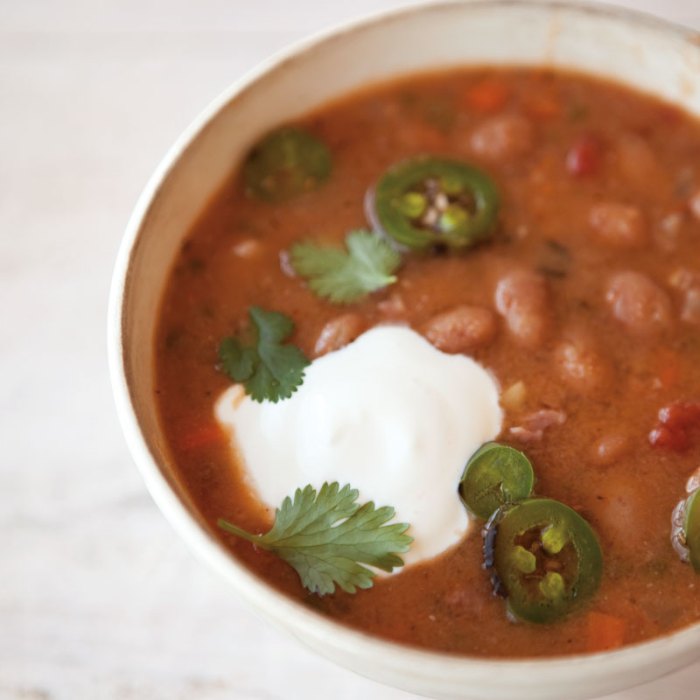
Source: williams-sonoma.com
This section provides serving suggestions, ideas for using leftovers, and pairings for pinto bean soup.
Five creative serving suggestions for pinto bean soup, including ideas for garnishes and side dishes:
- Garnish with chopped cilantro, a dollop of sour cream, and a squeeze of lime.
- Serve with crusty bread for dipping.
- Pair with a side salad for a refreshing contrast.
- Top with shredded cheese and avocado.
- Serve with tortilla chips for a more casual meal.
Three different ways to use leftover pinto bean soup in other dishes:
- Use as a filling for tacos or burritos.
- Incorporate into chili for added depth of flavor and texture.
- Use as a base for a hearty soup and stew.
| Bread/Accompaniment | Texture | Flavor Profile |
|---|---|---|
| Crusty Bread | Firm, slightly chewy | Neutral, complements the soup’s flavors |
| Cornbread | Crumbly, slightly sweet | Adds sweetness and a contrasting texture |
| Tortilla Chips | Crispy, light | Adds a salty crunch and complements the spice |
Visual Representation of a Recipe
This section describes the visual appeal of a perfectly prepared bowl of pinto bean soup and details how to create a visually appealing garnish.
A perfectly prepared bowl of pinto bean soup should be visually appealing, showcasing a rich, deep brown color with flecks of contrasting ingredients such as herbs, vegetables, or spices. The texture should appear hearty and comforting, with visible beans and a slightly thick broth. The presentation should be simple yet elegant, perhaps served in a rustic bowl.
A visually appealing garnish could include a swirl of sour cream or crème fraîche, a sprinkle of chopped cilantro, a few slices of avocado, and a wedge of lime. The ingredients should be arranged artfully, adding pops of color and texture to the soup. The garnish should complement, not overpower, the overall presentation.
FAQ Explained: Recipes Pinto Bean Soup
Can I use canned pinto beans instead of dried?
Yes, canned pinto beans offer convenience. However, dried beans generally result in a richer, more complex flavor. If using canned, rinse them thoroughly before adding them to the soup.
How long can I store leftover pinto bean soup?
Properly stored in an airtight container in the refrigerator, leftover pinto bean soup will generally last for 3-4 days. For longer storage, freeze in airtight containers for up to 3 months.
What can I do if my pinto bean soup is too thick?
Add broth or water gradually until you reach your desired consistency. Start with a small amount and stir well before adding more.
What if my pinto beans are mushy?
Overcooking is the likely culprit. Next time, monitor the cooking time carefully, especially if using a pressure cooker. Reduce cooking time slightly and check for doneness regularly.

